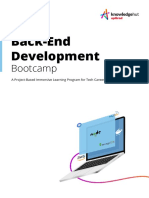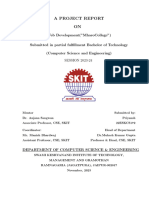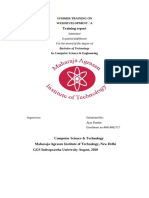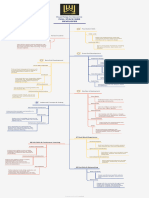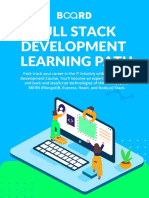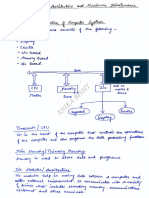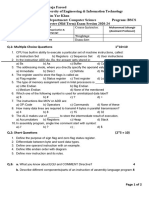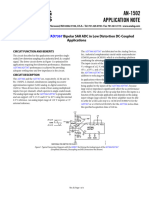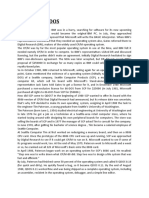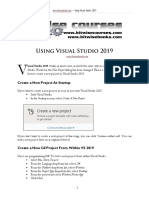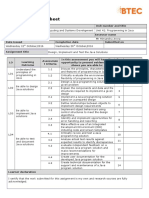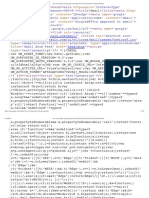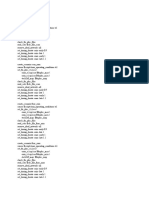A Professional IT Learning Program
“Mastering Web Application Development with Trending
Industry Practices”
Course Overview
The Mastering in Web Application
Development course aims to elevate the
skills of the IT manpower (working in web
application development). This course is
designed for professional software
engineers/developers who are at the early
stage(juniors/mid-levels) of their
professional career, offering in-depth
knowledge in advanced web application
development and its best industry
practices so that they can further
design/develop the web application
systems more effectively and efficiently.
Learners of the program will get the real-time knowledge and hands-on skills
from the senior experts of the same field who have already mastered the art of
building secure, performant, maintainable, modular and scalable web
applications, adhering to global standards.
Course Duration
Total Duration:
16 weeks
With Two-hour Daily Sessions.
Training Partner :
�Course Learning
Outcomes
By the end of this course, participants will be able to:
Deepen their understanding of advanced web application
development concepts and architectures.
Develop robust problem-solving abilities through hands-on
experience with debugging and performance optimization.
Build secure and resilient web applications by applying industry-
standard security practices.
Create exceptional user experiences through effective design and
development techniques.
Collaborate effectively within development teams and
communicate technical concepts clearly.
Stay at the forefront of web development by mastering emerging
technologies and trends.
Implement advanced development methodologies to streamline
project delivery and code management.
Training Partner :
�Learning
Methodology
A variety of assignments, tutorials, and lab tests for each module.
Regular feedback from both trainers and learners, with
adjustments made as necessary.
Rigorous monitoring and evaluation of progress throughout the
learning journey.
The program is broadly applicable to all web application
developers irrespective of programming language, but may be
delivered focussing on specific programming language and
frameworks or choice.
Training Partner :
�Target Participants:
By the end of this course, participants will be able to:
Deepen their understanding of advanced web application
development concepts and architectures.
Develop robust problem-solving abilities through hands-on
experience with debugging and performance optimization.
Build secure and resilient web applications by applying industry-
standard security practices.
Create exceptional user experiences through effective design and
development techniques.
Collaborate effectively within development teams and
communicate technical concepts clearly.
Stay at the forefront of web development by mastering emerging
technologies and trends.
Implement advanced development methodologies to streamline
project delivery and code management.
Training Partner :
�Prerequisites
Good foundation in at least one programming language among
Java, Python, C#, PHP, JavaScript, or a similar one, with solid
understanding of core programming concepts (variables, data
types, loops, conditional statements, functions, and object-oriented
principles etc.).
Familiarity with HTML, CSS, and basic JavaScript along with any
associated frameworks/libraries like BootStrap/Tailwind etc for
CSS and React/Angular/Vue etc for JavaScript for creating front-
end website structures.
Understanding client-server interactions and how the web
technology works.
Minimum 1+ years of professional working experiences as full stack
developer, web developer or similar is required.
Working knowledge of any Databases (Relational or Non-
Relational).
Basic understanding of Version Control Systems like Git.
Familiarity with cloud platforms (like AWS, Azure, or Google Cloud),
Docker, and CI/CD concepts would be helpful.
Training Partner :
�Course Breakdown:
Week Module Content Details
1 Web Application Understanding different web application
Architectures architectures: MVC, MVVM, MVP, Layered
architecture, Monolithic, Microservices, Micro
Frontends and Serverless architecture.
How to choose the right architecture for
different product requirements
Designing scalable and maintainable web
application structures
Backend and Frontend design considerations:
Controller, service, DAO, DTO, model, entity,
UI, UX
Common design patterns and principles: IoC,
SOLID Principles, Factory Patterns etc.
Understanding the Importance of WEB3
Demo web applications with various
architectures
Logging: How and Advanced logging techniques and frameworks
2
When?
Choosing the right logging level: debug, info,
warn, error
Structuring log messages for efficient
analysis, troubleshooting, monitoring, and
reporting
Integrating logging with monitoring and
alerting tools
Best practices for log rotation, storage, and
management
Training Partner :
� Effective Advanced debugging techniques with browser
3-4
Debugging developer tools
Debugging asynchronous code and network
requests
Debugging client-side and server-side issues
Using debugging tools for performance
profiling and memory analysis
Best practices for writing code for easy
debugging
How to write a clean code?
Importance of Unit/Integration/Mock Testing,
how and when?
API Design Request/Response Protocols
5-6
Practices
Importance and characteristics of APIs
SOAP vs. REST vs GraphQL
Payload conventions
Path and naming conventions
RESTful API design principles: resources,
verbs, responses
Designing clear, concise, and well-
documented APIs API Lifecycle Management
Effective testing and validation using tools like
Postman, Swagger or similar
Training Partner :
� Securing Web Introduction to web application security.
7-8
Applications
Advanced security threats and vulnerabilities:
OWASP top 10, SSRF, Injections, Business
Logic Flaws, Cross-Site Scripting, security
misconfigurations.
Security implications of modern and popular
web application development frameworks
Secured programming/coding best practices
Securing sensitive data and user interactions:
Data security principles,
Authentication and Authorization, Session
Management, XSS and CSRF Protection
Security testing for developers
Adoption of code analysis and vulnerability
identification tools
Security monitoring and incident reporting
Web Application Firewalls (WAFs)
DevSecOps and Cloud Security for developers
9-10 Performance Web Performance Fundamentals: load time,
Considerations responsiveness
and
Understanding performance bottlenecks
Optimization
Techniques
Front-end Optimization Techniques: image
optimization, minification, compression,
caching, lazy loading
Backend-end Optimization Techniques: server-
side caching, load balancing etc
Training Partner :
� ILoad testing and performance profiling using
tools like JMeter, WebpageTest
Scaling strategies for web applications
How containerization is helping for auto scaling
Optimizing web applications for different
devices and network conditions
Techniques for monitoring and analyzing
application performance
Database optimization consideration as Web
Developer, efficiently using ORM frameworks,
Stored Procedures
Choosing right databases(relation and non-
relational), when and how.
Git, its workflow, and naming conventions
11-12 Advanced
Version Control
Git branching strategies: Simple, Advanced,
Usages with Complex Projects
Best Practices
Advanced Git features: stashing, rebasing,
merging conflicts
Git hygiene: commit messages, branch
cleanup, gitignore, code review, merging,
feedback
Hands-on experience with Git collaboration
tools: GitHub, GitLab
Adoption of Git hooks for effective
development and CI/CD integration
Best practices for managing large codebases
and multiple code repositories
Training Partner :
�13-14 Prompt Understanding AI, Large Language Models,
Engineering for Generative AI
Web Developers
LLM working mechanisms, capabilities, and
limitations
Techniques of effective prompts
Understanding the impact of words, structure
of sentences, context for efficient prompt
design and creation
Writing prompts for code generation, quality
documentation, ideation, and debugging, and
understanding the future of prompt
engineering for web application development
Creating the effective AI Assistant for web
developers
15-16 Technical The art and importance of technical
Communication communication
and Project
Building technical vocabulary
Execution
Understanding technical documentation: API
documentations, user manuals, operating
manuals, design specifications
Importance of diagrams, flowcharts, and other
visuals for better technical communication
Adoption of communication with technical
background
Effective communication of development
works, requirements, and designs to technical
and non-technical stakeholders
Becoming a product developer
Training Partner :
� SDLC, Agile, Project Management Tools, and
Techniques
Understanding project development and
execution workflow
Integration of development pipeline with
project management pipelines
This course provides a robust foundation in web application development.
Participants will gain proficiency in essential technologies, design
principles, and security best practices, preparing them to build scalable
and secure web applications.
Thank you for going through the program! Please feel free to contact
us for further information or assistance.
Training Partner :
















